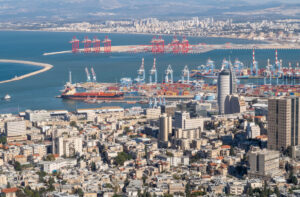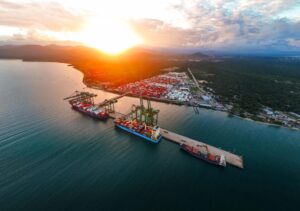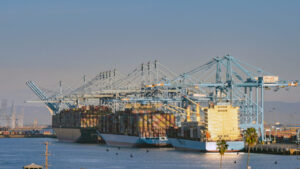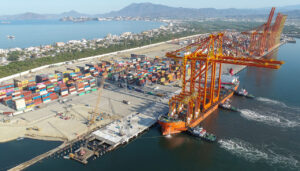With the recent emphasis placed on technological advancements and digitalisation in the global ports industry, we will look at the top five European ports that have made the most significant developments in this regard.
Ports worldwide have been growingly receptive to innovative technologies and digitalisation. Considering the globalised and consumerist nature of today’s world, the need to optimise efficiency and sustainability in and around ports is more pertinent than ever before. Ports must implement measures to keep up with the ever-evolving global trade landscape and the changing demands of the global supply chain.
As global trade continues to thrive, the size of ships and volume of cargo are reaching unprecedented levels, necessitating ports to adapt and accommodate these advancements. Port operators have recognised the potential benefits of smart technologies and are actively exploring their integration. The ports industry has experienced a surge in projects, conferences, and partnerships centred around technological innovations, indicating a growing emphasis on leveraging technology to enhance port operations.
READ: Smart Digital Ports of the Future 2023
The emergence of “smart ports” can be attributed to significant industry developments, where new technologies have become integral to modern logistics infrastructure. These technologies, including Artificial Intelligence (AI), Big Data, Internet of Things (IoT), and Blockchain, play a crucial role in enhancing productivity, sustainability, and efficiency within ports. By leveraging these technologies, smart ports streamline operations, improve security measures, and provide enhanced services to customers and stakeholders throughout the supply chain.
In summary, smart ports offer a multitude of benefits encompassing operational efficiency, cargo handling, congestion reduction, security, safety, reliable supply chain management, and economic development. Embracing smart technologies allows ports to enhance their competitiveness, adapt to evolving trade demands, and create sustainable growth for their respective regions.
Let us now look at the top five ports in Europe that have made the greatest strides in technological innovation.
5. Port of Barcelona
In fifth place, we have the Port of Barcelona. The Port of Barcelona has taken major strides in its digitalisation process in recent times with a plethora of smart and cutting-edge developments implemented at the port, including the deployment of the port’s Digital Twin, a cutting-edge technology that generates a digital replica of all activities taking place within the port’s area. This is consistent with the port’s ambitions of increasing the use of AI.
Quite recently, in June 2023, the Port of Barcelona revealed that its Board of Directors approved the construction process for a battery of seven underground conduits connecting the Energy and Adossat wharves. This infrastructure development is crucial for providing essential services to the expanding Adossat wharf, as stated by the port. Additionally, the construction is necessary for installing the medium-voltage network required to supply electric current to ships, in accordance with the Nexigen dock electrification project.
Additionally, in May 2022, the Port of Barcelona unveiled its latest Innovation Plan, introducing its innovation model built upon the concept of a smart port. The plan emphasizes the importance of sustainable, open, collaborative, demand-driven, strategy-aligned innovation with a robust technological foundation. The scheme sets forth three primary objectives: bolstering the Port of Barcelona’s role as a catalyst for economic growth and recovery, promoting innovation and digitisation within the logistics ecosystem, and fostering synergies with the city in this domain.
The port also partnered with PTI in September 2022, for its annual Smart Ports: Piers of the Future event this year. Among the focus points of the event was technological innovation. The three-day event also saw speakers and representatives touch on areas including sustainability, innovation, and upskilling workforces.
4. Port of Valencia
The Port of Valencia secures the fourth position on our list of most automated ports in Europe, thanks to its significant technological advancements over the past year.
In late June 2023, Valenciaport collaborated with Nextport on the creation of an innovative software designed to forecast the volume of trucks expected to traverse the port’s facilities. The new AI system compounds Valenciaport’s data – both land and seaside – with relevant information to understand the behaviour of the ship on arrival at the port. With this software, Valenciaport can predict in advance what is going to take place in the Valencian docks both in terms of loading and unloading of ships, alongside the movements that will take place at the terminal gates and the number of truck entries.
In early April, the Port of Valencia accomplished a notable feat by training 2,600 lorry drivers in utilising the ValenciaportPCS mobile application. This training initiative aimed to promote the adoption of the app, which was developed by the port itself, to enhance operational efficiency and convenience for drivers. The app, according to the port, offers several benefits including reduced waiting times, lower emissions, paperless operations, streamlined procedures, and support for environmental sustainability. The training process concluded on a positive note, with drivers sharing their experiences and feedback to contribute to ongoing improvements of the digital tool.
Perhaps the port’s biggest technological advancement in the past year is its substantial investment of $1.64 billion in a new container terminal. Operated by TIL of the MSC group, this terminal is expected to become the world’s most environmentally friendly, while also generating a positive impact on the local and national economy. More notably, the terminal aims to minimise CO2 emissions by an impressive 98 per cent through the electrification of its driving components and installations of the terminal. Additionally, it will solely rely on renewable energy sources for all electricity needs and provide ship connectivity to the grid during port stays.
On top of this, the new terminal will boast state-of-the-art design, advanced technology, and cutting-edge equipment, along with a fully electrified infrastructure. These enhancements will enable the terminal to efficiently accommodate the increasingly large container ships now in operation.
3. Port of Antwerp-Bruges
Third on our list of the top five automated ports in Europe is the Port of Antwerp-Bruges.
Serving as a central component, the Port of Antwerp-Bruges has implemented a Digital Twin that integrates various initiatives within the port’s digital nervous system. Its primary purpose is to provide situational awareness for all port employees, offering a comprehensive view of operations and facilitating informed decision-making.
In March 2023, the Port of Antwerp-Bruges, along with its partners Dronematrix, Skeydrone, and Proximus, received approval to deploy their drone in a box network called D-Hive. Building on this development, in May 2023, the port introduced the ‘D-Hive drone-in-a-box’ network, primarily aimed at enhancing security within the port area. This network comprises six autonomous drones that will cover a vast area of over 120 square kilometres, ensuring comprehensive surveillance and monitoring capabilities throughout the Antwerp port region.
The primary objective of deploying these drones is to provide port authorities with a unique aerial perspective, enabling efficient management, inspection, and supervision of extensive land areas. The drones will play a crucial role in various tasks such as berth management, infrastructure inspections, monitoring operations, detecting oil spills and floating waste, as well as supporting security partners during incidents. By harnessing the capabilities of these drones, the Port of Antwerp-Bruges aims to enhance operational efficiency, safety, and environmental monitoring, while also facilitating prompt response and decision-making in critical situations.
Late last year, the Port of Antwerp-Bruges obtained approval for the $324.6-million renewal project of the Europa Terminal. This significant undertaking involves comprehensive renovations aimed at creating an efficient and sustainable terminal, aligning with the port’s commitment to transitioning towards a climate-neutral port. A notable aspect of the renewal project is the implementation of electrification and optimisation procedures, which are expected to achieve a substantial annual reduction of 50 per cent in CO2 emissions.
2. Port of Hamburg
Coming in second on our list is the Port of Hamburg.
In early June, Hamburger Hafen und Logistik AG (HHLA) and ABB Ltd. partnered to increase efficiency in the long-term operation of big automated stacking crane (ASC) systems. The partnership will be ongoing until the end of 2025 and it aims to unlock potential for the further development of systems for automatic stacking cranes as well as their use, maintenance, and servicing.
Later that same month, the electrification project of the storage area at Hamburger HHLA’s Container Terminal Burchardkai (CTB) took its latest step with the start of operations of four new modern storage blocks. The latest developments will reportedly drive forward the decarbonisation of workflows alongside the reduction of emissions at the Port of Hamburg.
In early 2022, the Hamburg Port Authority (HPA) and DAKOSY Datenkommunikationssystem were awarded a grant of $17 million by the Federal Ministry of Digital and Transport (BMDV) to establish a digital test bed at the Port of Hamburg. The funding will be used to support the Services and Data Network Port of Hamburg (SANTANA) project, which spans 30 months. The objective of SANTANA is to develop infrastructure that enables closer integration between privately organised logistics, public infrastructure, and traffic management. This investment aims to facilitate the advancement of digitalisation and connectivity within the port, enhancing efficiency and effectiveness in the movement of goods and services.
In conjunction with the grant mentioned earlier, the Hamburg Port Authority (HPA) established a technology partnership with HHLA Sky, primarily aiming to leverage the utilisation of automated drones at the Port of Hamburg. By incorporating automated drones, the HPA and HHLA Sky aim to improve efficiency, safety, and effectiveness in tasks such as surveillance, inspections, and logistics management at the port.
1. Port of Rotterdam
Considered an industry pioneer having spearheaded the technological shift in the ports industry, the Port of Rotterdam secures the highest position on our list.
The port has been incredibly active in the last year with introducing, testing, and implementing new technologies. This includes the port’s IoT project which involved the deployment of a sensor network in a 12,500-hectare port area, alongside the port’s ambitious Digital Twin project.
A notable development occurred in late March 2023, when the Port of Rotterdam Authority installed six “smart bollards” along the quay of the Hutchison Ports ECT Delta terminal on the Maasvlakte. These bollards were strategically positioned side by side at a berth dedicated to accommodating large containerships at the Port of Rotterdam.
These bollards measure the strength of the mooring lines. By obtaining this data, the port aims to enhance its understanding of the implications of berthing, docking, and idle periods for containerships at the quay. This installation of six bollards aligns with the port’s broader commitment to enhancing safety and efficiency in port operations through digitalisation.
Additionally, earlier in the year, the Port of Rotterdam adopted an integrated planning solution called Nextlogic, which was specifically designed to manage the port’s inland container shipping operations. The primary objective of Nextlogic is to enhance the efficiency and promptness of handling inland vessels while optimising the utilisation of quays. It achieves this by continuously updating the most optimal schedules for barge operators and terminals, operating on a round-the-clock basis.
Moreover, the Port of Rotterdam made significant advancements in enhancing communication systems within and around the port with the deployment of a new secure quantum network by Q*Bird. This network enables multiple users to connect through a central hub located at the Port of Rotterdam, offering enhanced security and reliability.
The newly deployed quantum network will establish connections between users and the Port of Rotterdam’s data-sharing platform, Portbase, as well as several other logistics companies situated within the port. Efficient communication systems are of utmost importance for the Port of Rotterdam, which handles a substantial volume of 15 million TEU annually. Consequently, this technological advancement is professed to enhance the safety of tens of thousands of sea vessels each year.


















